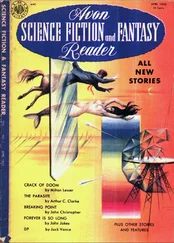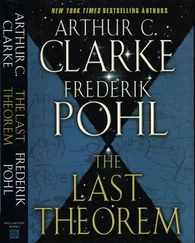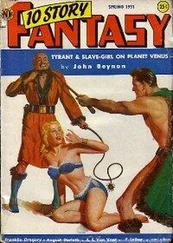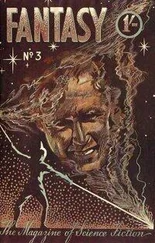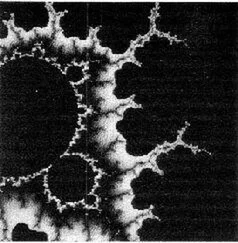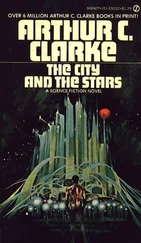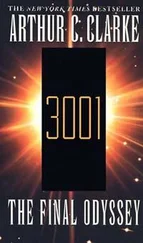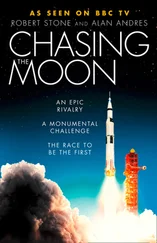It was not easy to observe Jupiter V. The tiny moonlet, only a hundred miles in diameter, was so close to Jupiter that it spent much of its time eclipsed in the planet's enormous cone of shadow. And even when it was in the sunlight, it moved so rapidly that it was hard to find and to keep in the field of view.
The fly-by on the morning of that second Joveday was not very favorable, the satellite was twenty thousand miles away, and visible only for about ten minutes. There was time for nothing more than a quick look through the telescopes, while the cameras snapped a few hundred shots of the rapidly vanishing little world.
The detailed examination of the photos would take several hours; after a while the endless repetition of impact craters, fractured rocks, and occasional patches of frozen gas produced something close to boredom. But no one could tear himself away from the screen; and at last, after more than half the stored images had been scanned, patience was rewarded.
The crucial sequence had been taken with a telephoto lens, just as Jupiter V was emerging from shadow. At one moment there was a black screen; then, magically, a thin crescent suddenly materialized, as the little moon came out of eclipse.
Kimball was the first to spot the curious oval patch near the terminator. He froze the picture, and zoomed in for full magnification. As he did so, there were simultaneous gasps from all his colleagues.
Part of the side facing Jupiter had been sheared off flat, as if by a cosmic bulldozer, leaving a perfectly circular plateau several miles across. At its center was a clear-cut, sharply defined rectangle, about five times as long as it was wide, and pitch-black. At first glance it seemed to be a solid object; then they realized that they were staring into shadow; this was an enormous hole or slot, wide enough to engulf Discovery, and extending deep into the heart of Jupiter V. It was at least a quarter of a mile in length, and perhaps a hundred yards wide.
Time and geology could play some odd tricks with a world; but this was not one of them.
It was an unusually quiet and subdued group that gathered in the artificial gravity of the carousel for the luxury of coffee that could actually be drunk from cups, not squirted from plastic bulbs.
The wonder and the excitement of the discovery had already passed, to be replaced by more somber feelings. What until now had been only a possibility-and, to tell the truth, rather a remote one-had suddenly become an awesome reality. That pyramid on the Moon had been astonishing, but it was only a tiny thing. This was something altogether different-a whole world with a slice carved off, just as one may behead an egg with a knife.
"We're up against a technology," said Bowman soberly, "that makes us look like children building sandcastles on the beach."
"Well," answered Kaminski, "we suspected that from the beginning. Now the big question is-are they still here?"
Jupiter V looked utterly lifeless, but an entire civilization could exist, miles below the surface, at the bottom of that rectangular chasm. The creatures who put TMA-1 on the Moon, three million years ago, could still be going about their mysterious business.
Perhaps they had already observed Discovery, and knew all about this mission. They might be totally uninterested in the primitive spacecraft orbiting at their threshold; or they might be biding their time.
This was the situation classified in the mission profile as "Evidence of intelligent life-no sign of activity," and the response had been outlined in detail. They would do nothing for ten days except transmit the prime numbers 1 . . . 2 . . . 3 . . . 5 . . . 7 . . . 11 . . . 13 . . . 17, at intervals of two minutes, over a broad band of the radio spectrum. Luckily, the loss of the main antenna complex did not affect this operation; the low-powered equipment on the Control Deck was quite adequate for such short-range work.
They called, and they listened on all possible frequencies; but there was no reply. Though this could indicate many things, it began to seem more and more likely that the tiny moonlet was abandoned. It was hard to believe that it could ever have been anything except a temporary encampment for an expedition-from Jupiter itself, or from the stars?
While they were waiting and watching, and continuing to survey the other four moons whenever the opportunity arose, Bowman prepared for the next step. If it was physically possible, Discovery would make a rendezvous with Jupiter V.
Kaminski spent hours considering approach orbits; Athena spent seconds computing them. The maneuver was a very difficult one, for though Jupiter V's own gravity was negligible, the satellite was trapped deep in Jupiter's enormous gravitational field. Discovery would have to make a speed change of over twenty thousand miles an hour to match orbits and achieve a rendezvous.
It could just be done-and, ironically, only the earlier disasters made it possible. The ship was more than a ton lighter than expected at this stage of the mission, for it had lost two crew members, a spacepod, and the antenna complex. That was enough to make the difference between a maneuver that was barely feasible, and one which had a good safety margin.
Once Discovery had entered the parking orbit around Jupiter V, she could never leave it; her propellant reserves would be completely exhausted. And though the recovery ship would hardly expect to find her here, it would soon spot her radio beacon and her flashing strobe lights. Nuclear batteries would power them for twenty years; their detectable range was only about a million miles, but that was ample.
As soon as he was sure of the calculations, Bowman wasted no more time. The ten days were up: Jupiter V was still silent. The mission profile said: "Proceed with caution-in the event of hostility, withdraw."
That was excellent advice-except that retreat would be impossible. Once they had used their final reserves, they would be wholly committed.
After more than fifty orbits of Jupiter V, they had mapped and inspected its entire surface, most of which was covered with an icy rime of frozen ammonia. There was no sign of life, no hint of any activity. A search for radio emissions or electrical interference was fruitless; the little moon appeared to be completely dead. The theory that it was some kind of abandoned base, perhaps even a deserted city-world that ages ago had come here from some other solar system, slowly gained ground. Hunter was its chief advocate; when asked where he thought the hypothetical star– people had gone, he answered: "I think they were our ancestors." He was more than half serious about this, and refused to budge in the face of all the anthropological and geological evidence that could be thrown at him.
On the fourth day they dropped two of the ship's soft-landing probes-one on Kimball's Plain, the other at its antipodes. The radioed reports were inconclusive: the seismographs could detect no tremors-the sensitive geophones, not a whisper of internal sound. As far as the instruments could tell, Jupiter V was a dead lump of rock.
After two more days of waiting to see if anything had emerged to investigate the probes, Bowman made his decision. The others had been expecting it; from time to time, each had quietly hinted to Bowman that he should be the one to make the first reconnaissance.
In the carousel lounge, which had once seemed so small but was now, alas, larger than they required, he outlined the plan.
"We have only two pods," Bowman began, "and I'm going to commit them both: I think it will be safer that way. If one gets in trouble, the other will be there to help.
"Two pods will go down to the surface; one will stay on the brink of the chasm and the other will go in for a distance of not more than a thousand meters-less, if there's the slightest sign of danger. I'll take the forward one; Jack will be my Number Two."
Читать дальше


